#early prolific straightneck squash
Text

Instagram Repost: July 3, 2022
Man, I'm really loving these Saffron Prolific Straightneck Summer Squash I planted this year. They're such great growers, are tolerating our summer heat well so far, and are near constantly blooming. Plus, they actually seem to be producing; the first variety I've managed to get to do so in my history of gardening despite years of trying. The only things they don't seem to like is a trellis or basket (which is a shame).
Honestly … Forget the Crooknecks I'm always recommended … Hell, even the Early Prolific Straightnecks I bought that are recommended for my zone aren't doing half as well, ha! I think it's safe to say that, after this year, these are easily going to become my go-to staple if I want Squash. Still on the hunt for a good Cucumber and Zucchini variety, though, sadly. But eventually I'll find one.
#Instagram Reposts#2022#Personal#Verderer#Gardening#Garden 2022#Green Witch#Green Witchcraft#Oklahoma#Witchy Gardening#Witches Garden#Witch's Garden#Gardenblr#Plantblr
1 note
·
View note
Text
Early Prolific Straightneck Summer Squash Seeds | Heirloom | Organic
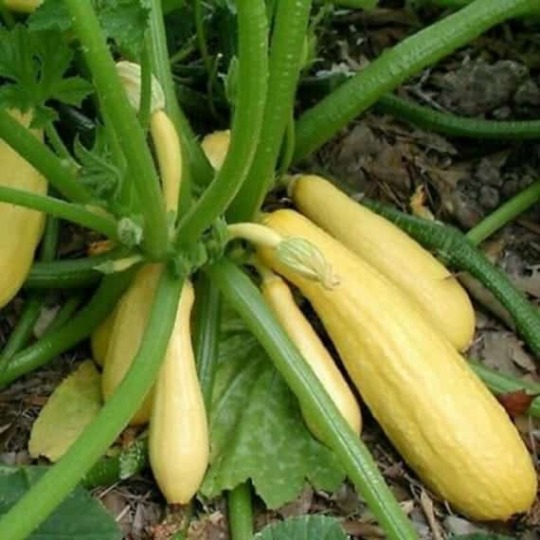
Introducing Early Prolific Straightneck Summer Squash Seeds - your gateway to a summer garden brimming with vibrant, organic produce.
I'm thrilled to personally endorse this heirloom, organic treasure that will elevate your gardening experience. Here's why Early Prolific Straightneck Summer Squash Seeds deserve a spot in your garden:
Abundant Harvests: If you're tired of waiting for meager harvests, these seeds hold the solution. Early Prolific Straightneck produces a bounty of delicious squash, ensuring your kitchen is stocked all season long.
Space-Saving Growth: With its compact growth habit, this squash is perfect for smaller garden spaces, containers, or raised beds. Say goodbye to overcrowding and hello to efficient space utilization.
Culinary Delight: The tender, succulent flesh of Early Prolific Straightneck Summer Squash is a culinary treasure. Whether sautéed, grilled, or baked, its flavor and texture make it a versatile choice for various dishes.
How do I germinate Early Prolific Straightneck Summer Squash Seeds?
Begin by planting the seeds indoors in well-draining soil. Provide warmth and sunlight to encourage germination. Once the threat of frost has passed, transplant the seedlings outdoors in a sunny spot.
How many squash can I expect per plant?
Depending on growing conditions and care, you can anticipate multiple squash per plant. Early Prolific Straightneck lives up to its name with its generous yields.
Are these seeds suitable for organic gardening?
Absolutely! Our Early Prolific Straightneck Summer Squash Seeds are organic and heirloom, aligning perfectly with your commitment to organic gardening.
I have limited gardening space.
Early Prolific Straightneck's compact growth ensures you can enjoy a rewarding harvest even in smaller gardens or containers.
I'm unsure about seed quality.
Our Early Prolific Straightneck Summer Squash Seeds are hand-selected for their exceptional quality and reliable germination rates.
I want versatile squash for cooking.
Early Prolific Straightneck's tender flesh is a culinary marvel, adapting beautifully to various cooking methods and recipes.
Don't let another season go by without experiencing the abundance and flavor of Early Prolific Straightneck Summer Squash in your garden.
These heirloom, organic seeds are your ticket to a thriving harvest and culinary inspiration.
Embrace the opportunity by clicking below to purchase the product and embark on your summer squash-growing adventure!
Read the full article
#bulkseeds#earlyprolific#heirloomzucchini#organiczucchini#seeds#SQUASH#squashseeds#strightneckzucchini#summersquash#vegetableseeds#yellowzucchini#zucchini#zucchiniseeds
0 notes
Text


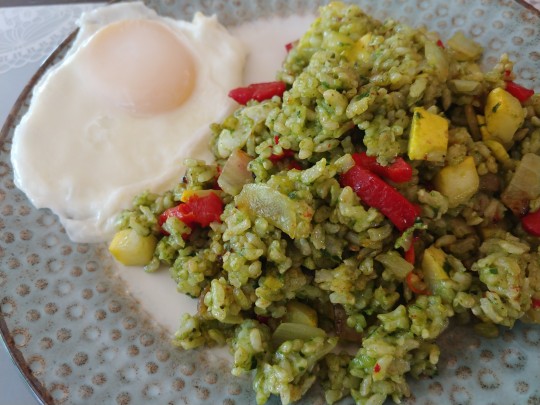

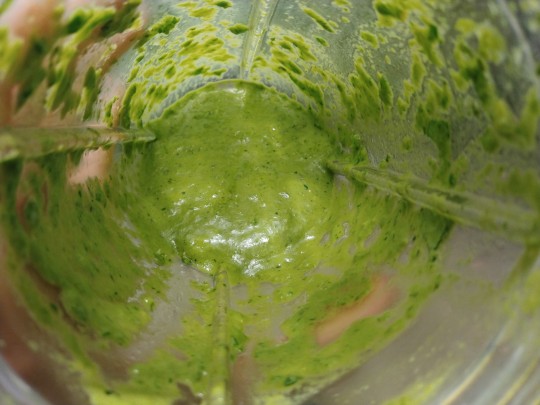
06/06/2020: It's that time of the year! Basil time!
Instead of a typical pesto pasta, I made pest rice. Pine nuts are super expensive so I mixed in some squash in the pesto. I thought it will mellow the flavor and make it creamier and it sure did!
As a veggie grower, there is no better feeling than to cook what I grow. You know, some restaurants brag about being Farm-to-Table, but the truth is....my own Garden-to-Table is way more fresh and more satisfying.
Mmm...this pesto rice was so yummy I'm sure I'll make it again and again!
#pesto#basil#early prolific straightneck squash#squash#las vegas gardeners#gardenersworld#gardenerslife#gardeners on tumblr#las vegas gardening#growveggies#growvegetables#gardenblr
6 notes
·
View notes
Text
Today’s Plantings
Sowed:
1 pot of Napoli F1 Carrots by Territorial Seed ($4.35 1g)
3 pot Early Prolific Straightneck Yellow Squash by Botanical Interests ($2.29 2g)
2 pot Royal burgundy Bush Beans by Territorial Seed ($2.55 1g)
2 pot Ferrari Bush Bean by Botanical Interests ($2.69 4g)
2 pot Progress #9 Peas by Botanical Interests ($2.49 15g)
1 rail planter Sugar Ann Snap Pea by Terrorital Seed
1 rail planter Spacemaster 80 Cucumber by Botanical Interests ($1.89 2g)
Started in rockwool cubes:
2 Optima Butterhead Lettuce by Territorial Seed ($3.95 1/2g)
2 Red Russian Kale by Botanical Interests ($1.99 1g)
2 Rocket Arugula by Territorial Seed
4 Wild Garden Kale by Territorial Seed ($3.50 1g)
Started in Peat Pellets:
2 Sun Gold Cherry Tomato by Botanical Interests ($3.89/10 seeds)
2 Thompson Broccoli by Territorial Seed ($3.95 1/4g)
2 Halbhoher Kale by Territorial Seed ($3.95 1/2g)
3 Wild Garden Kale by Territorial Seed ($3.50 1g)
1 note
·
View note
Text
the garden is huge and beautiful. not getting a whole lot of food out of it, yet, but we’ve had some great early producers. all of the squash are getting big, but the early prolific yellow straightneck has been producing edible fruit since the first week of June and continues to do so at a steady rate, while the crookneck and the zuchinni are lagging behind in fruit production.
the roma and the minibel tomatoes are loaded with green tomatoes: the romas were seeded first, so that makes sense (they’re also a shorter-season determinate) but the minibels were planted at the same time as the yellow pear and the st. pierre, and they are already starting to produce. i really love the minibels, despite some of their shortfalls (stems break really easily, which is a bummer when you’re trying to hand pollinate a blossom and the whole thing breaks clean off) and i think i’d like to try these again next year, started earlier, and perhaps put in their own flowerbed-type plot. this would free up space in the main garden and would allow - hopefully - for lots of early season tomatoes.
the st pierre are developing (closed) blossoms, and i have three yellow pear tomatoes started on one plant. trying to be patient with these, because i know they’re an indeterminate that will explode with tomatoes once they reach a certain maturity.
1 note
·
View note
Photo

I may be a little crazy. Bigger garden means I have more space for more plants. Roll call in case you can't read the labels: common thyme, lemon basil, broad leaf sage, dark opal basil, true lavendar, rosemary, sweet banana pepper, lemon cucumber, purple top white globe turnip, early whire vienna kohlrabi, red and green romaine, little marvel peas, grey zucchini, early prolific straightneck squash, shooting stars eggplant, sour gerkin, hendersons baby lima beans, clemson spineless okra, san marzano tomato, rattlesnake pole beans, cherokee purple tomatoes, black turtle shelling beans, cream peas, and red russian kale. Not pictured is my package of moringa seeds. https://www.instagram.com/p/Cb-e9apOkFt/?utm_medium=tumblr
0 notes
Text

Squash Early Prolific Straightneck 1g 1 Seed Packet http://rover.ebay.com/rover/1/711-53200-19255-0/1?ff3=2&toolid=10039&campid=5337982659&item=223993646335&vectorid=229466&lgeo=1&utm_source=dlvr.it&utm_medium=tumblr
0 notes
Text
Hybrid vs. Heirloom Seeds
By Jean Smith – I am a diehard for plants grown from heirloom seeds, and I save most of my own seeds for our farm. I thought now would be a good time to give a lesson on the basic differences between hybrid and heirloom seeds. We’ll look at specific definitions of hybrid and heirloom seeds and then I will give my own personal feelings on the two, as well as some of my favorite varieties along with some resources!
Heirloom Seeds
The definition and use of the word “heirloom” to describe plants is fiercely debated. One school of thought places an age or date point on the cultivars. For instance, one school says that for heirloom seeds, the cultivar must be more than 100 years old, but others say 50 years, and others prefer the date of 1945, which marks the end of World War II and roughly the beginning of widespread use of hybrid seeds by growers and seed companies. Many gardeners consider 1951 to be the latest year a plant can have originated and still be called heirloom seeds, since that year marked the widespread introduction of hybrid varieties. It was in the 1970s that hybrid seeds began to proliferate in the commercial seed trade through the top seed companies. Some heirloom plants are much older, some being apparently pre-historic.
Ready to Start Your Own Backyard Flock?
Get tips and tricks for starting your new flock from our chicken experts. Download your FREE guide today! YES! I want this Free Guide »
Another way of defining heirloom seeds is to use the definition of the word “heirloom” in its truest sense. Under this interpretation, a true heirloom is a cultivar that has been nurtured, selected, and handed down from one family member to another for many generations.
Additionally, there is another category of cultivars that could be classified as “commercial heirloom seeds,” cultivars that were introduced many generations ago and were of such merit that they have been saved, maintained, and handed down — even if the seed company has gone out of business or otherwise dropped the line. Additionally, many old commercial releases have actually been family heirlooms that a seed company obtained and introduced.
Regardless of a person’s specific interpretation, most authorities agree that heirloom seeds, by definition, must be open-pollinated. They may also be open-pollinated varieties that were bred and stabilized using classic breeding practices. While there are no genetically modified tomatoes available for commercial or home use, it is generally agreed that no genetically modified organisms (GMOs) can be considered heirloom seeds. Another important point of discussion is that without the ongoing growing of heirloom plants and storage of heirloom seeds, the seed companies and the government will control all seed distribution. Most, if not all, hybrid plants, if regrown, will not be the same as the original hybrid plant, thus ensuring the dependency on seed distributors for future crops.
Hybrid Seeds
Overview: A hybrid plant is a cross between two or more unrelated inbred plants. Hybridization has brought huge improvements, including more vigorous plants, improved disease resistance, earlier maturity, more uniform growth and increased yield. There are several different types of hybrid seeds and plants to be aware of:
F1 Hybrids
Seed saved from the first cross-pollination of two unrelated open-pollinated plants is called F1 hybrid seed. (F1 stands for Familial 1.) Each of the parents contributes attributes that, when combined, produce an improved type of plant.
Hybrid Vigor
A frequent characteristic of F1 hybrids is much-increased vigor. This can take the form of faster growth to maturity, larger root and top growth, and increased productivity. The gains from what is called heterosis greatly exceed the sum of what the parent plants might be expected to produce. Despite recent advances in the understanding of plant genetics, there is still no agreement among scientists about what causes heterosis.
Disease Resistance
Like other living things, plants are vulnerable to a range of diseases that can cause disappointment in a home garden and huge financial losses in agriculture. One trait that is constantly sought in plant hybridization is resistance—or at least tolerance—of diseases that can affect productivity. In seed catalogs, resistance is noted in an abbreviation after the plant variety name. For example, “Arbason F1 Hybrid, FW (races 0, 1), VW, TMV” means that this tomato has resistance to fusarium wilt races 0 and 1, verticillium wilt and tomato mosaic virus.
Uniform Growth
While the taste and appearance of open-pollinated and heirloom plants are highly valued, the size and growth rate of fruit and leafy= parts can vary widely. Hybridization can stabilize growth factors, so the grower can harvest much more uniform produce.
Maturity and Yield
In agriculture, the ability to produce a crop early in the season has considerable marketing advantages across all planting zones. The first corn, the first tomatoes, and the first strawberries always command higher prices. Hybrids can be created to achieve this, as well as higher yield, although it is often true that this extra-early produce does not have the full taste of later varieties.
Later Generations
The seed of open-pollinated or heirloom plants can be saved, and when sown will produce plants that are essentially identical to the parent plant. The seed from F1 hybrid plants, called F2 hybrids, will not produce a copy of the parent. Instead, the F2 plant will exhibit “break-up” in the form of random characteristics from either parent or possibly an even earlier trait. What this means is that F1 hybrid seed has to be created from scratch every year by laboriously hand-crossing the parent plants. This helps to explain why hybrid seed can be so expensive.
Read more: Definition of Hybrid Plants: Garden Guides.
Well, that is all the “formal” stuff. Now on to the basics. Heirloom seeds, in my opinion, and I believe most who grow them, will testify to overwhelmingly better flavor. Honestly, it’s not even just better, most of you who have eaten a grocery store tomato and then a fresh tomato know the difference. What most consumers don’t know is that those perfectly shaped tomatoes in the grocery store were picked rock hard green, packed and put in the back of a semi and then gassed to ripen on “the road.” That is why they are flavorless! Think about it … why do you think they intentionally say “Vine Ripened” on the little tomatoes on “the vine?” They have to tell you because they know the others weren’t.
Hybridization has been utilized for making veggies travel-worthy. For example, Brandywine tomatoes have extremely thin skins, therefore making them terrible “travelers.” As a market grower, I do not grow Brandywines for market because they will crack and split before they get to market, thereby making them unsellable, although I love them for my home garden and canning.
Uniformity in shape and size is also a must for grocery stores, not so for market tables. I love to put several different sized and colored heirloom tomatoes in a quart container — it is simply beautiful.
What some people also don’t realize is that there is a big difference between a hybrid and a GMO seed. This is where scientists have actually inserted a gene from another species into a vegetable. For example, putting a fish gene in a tomato … yes, they really do, and they say they have really good reasons for it. GMOs are not what I am going to get into here, though, because that is a really lengthy topic in its own right. You can do your own research, but please understand; most vegetable seeds are not GMO. GMO crops are focused on crops such as corn, soy and alfalfa.
Here are some of my personal favorite heirloom seed varieties for home gardening:
Tomatoes:
Beefsteak: Pineapple, Brandywine- all colors, Paul Robeson, Dr. Whyche’s, Hillbilly
Romas: Super Italian Paste, Plum Lemon, Roman Candle, all the Icicles, Striped Roman
Salad types: Green and Red Zebra, Woodle Orange, Rose De Berne, Stupice, White Tomesol
Cherry and grapes: Reisentraube, Violet Jasper, Blondkopchen, Red & White Current, Chocolate Cherry, Sungold, Yellow Pear
Lettuces:
Rein’s De Glace, Merriville de Four Seasons, Grandpa’s, Red Oak Leaf, Jericho, Forellenschulus, Rubin’s Romaine, Butter Crunch, Lolla Rossa, May Queen, Paris Island Cos, Rouge D’Hiver
Radishes:
White Icicle, Purple Plum, French Breakfast, Cherry Belle, Black Spanish, Pink Beauty
Winter Squash Varieties:
Walthams Butternut, acorn, Sweet Dumpling, Delicata, spaghetti, Green or Orange Buttercup
Summer Squash:
Round De Nice, Fordhook Zucchini, Prolific Straightneck, Patty Pan, Starburst
Carrots:
Cosmic Purple, Lunar White, Amarillo, Atomic Red, Chantenay Red Core, Danvers Long
Cucumbers:
Lemon, Marketmore 76, Boston Pickling
Eggplant:
Rosa Bianca, Black Beauty, Purple Long, Thai Long
Sweet Corn:
For most home gardeners, it is hard to move away from the hybrids because of the Super Sweet genes that have been introduced in them, but if you want to try an heirloom, Golden Bantam is a very good one.
Peppers:
Sweet: Jimmy Nardello—my personal favorite—long, sweet frying pepper, Red & Golden Marconi, Purple Beauty, Sweet Chocolate,
Hot: Early Jalapeno, Anaheim, Hungarian Hot Wax
Peas:
Mammoth Melting Sugar, Sugar Snap, Lincoln
Chard:
Rainbow, Fordhook, Golden
Spinach:
Bloomsdale Longstanding, New Zealand, Merlo Nero
Beets:
Detroit Dark Red, Early Wonder, Chioggia, Golden Detroit, Crosby’s Egyptian, Cylindra, Bulls Blood
Beans:
String: Blue Lake Bush, Contender
Wax: Golden Wax
Roma: *Roma, Dragon Tongue, Purple Podded Pole
Cabbage:
Late Flat Dutch, Early Jersey Wakefield, Henderson’s Charleston Wakefield, Perfection Drumhead Savoy, Mammoth Red Rock
Broccoli:
Calabrese, Waltham 29, Green Sprouting
Cauliflower:
Purple of Sicily, Giant of Naples, Snowball Self Blanching
RESOURCES
Here are a few of my favorite seed catalogs to order from:
• Baker Creek Heirloom Seed
• Fedco Seeds
• Johnny’s Selected Seeds
• Seed Savers Exchange
Here are a couple recipes — enjoy!
Roasted Carrot Soup
6-8 medium carrots, cleaned and scrubbed, cut into 1-inch pieces
1 cup coarsely chopped onion
1 tablespoon olive oil
2 14.5-ounce cans chicken broth
1 teaspoon smoked paprika
1 teaspoon lemon juice
Salt and black pepper
Preheat oven to 425°F. Toss carrots and onion with oil to coat. Spread veggies in a single layer in a shallow baking pan. Roast for 20 minutes or until tender.
In a large saucepan combine roasted vegetables, broth, and paprika. Bring to boiling. Cool slightly.
Transfer half the vegetable mixture at a time to a blender or food processor. Blend or process until smooth. Return mixture to saucepan. Add lemon juice. Heat through. Season with salt and pepper.
Poached Beets
3/4 cup apple juice
1/2 cup water
1 tablespoon packed brown sugar
2-1/2 pounds beets, peeled and cut into bite size pieces
Salt and pepper
Honey
1 tablespoon snipped fresh parsley
In a large saucepan combine 1/2 cup of the apple juice, the water, and brown sugar. Bring to boiling, stirring to dissolve sugar. Add beets. Return to boiling; reduce heat. Simmer, covered, about 45 minutes or until beets are tender and can be pierced with a fork, stirring occasionally. Drain.
2. Transfer beets to serving bowl. Sprinkle remaining juice over beets. Season to taste with salt & pepper. If desired, drizzle with honey.
Originally published in the March/April 2013 issue of Countryside & Small Stock Journal and regularly vetted for accuracy.
Hybrid vs. Heirloom Seeds was originally posted by All About Chickens
0 notes
Text
¡Sí, seguimos aquí!/Yes we’re still here!
Cuatro meses después, hemos completado ese hilo de limoncillos conectando las dos parcelas, y hemos hecho muchísimo más también. Estos cuatro meses han sido full de transiciones, de misiones cumplidas y mil más planificadas e iniciadas – de verdad demasiado para intentar describir aquí. Como siempre pasa, uno se abruma por lo tanto que hay que escribir y se paraliza, y al final no escribe nada. Mejor, digo yo, es simplemente escribir desde ahora sin preocuparse por lo que puede faltar. Mejor escribir algo que nada – ¿cierto?
La meta prioritaria ha sido producción de comida. El plan es combinar la cría de gallinas ponedoras alimentadas por compost (o, mejor dicho, por el proceso de hacer compost) con la siembra de hortalizas, usando el trabajo de las gallinas preparando y abonando el suelo más el compost para poder sembrar sin arar el suelo (excepto para arrancar plantas voluntarias especialmente porfiadas). El problema es que aún no hemos podido implementar el sistema de cría de gallinas, de hecho no hemos podido conseguir ni siquiera unas pocas gallinas para empezar, así que estamos sembrando sin su trabajo, sin su abono y sin el compost! He pasado bastante tiempo preparando suelo para sembrar, poco a poco, y al sembrar cada planta le echo un puñado del poco compost de bosta que nos queda de lo que compramos hace un par de años y cruzo los dedos.
Claro, echo mulch – una palabra que falta en castellano, material orgánico que cubre el suelo para evitar erosión y evaporación, protegerlo de temperaturas extremas (en nuestro caso calor) y viento, y eventualmente descomponer y aumentar la capa vegetal. He agregado mulch a nuestra lengua aquí en la Casa Abya Yala, además del verbo mulchar, la acción de echar mulch, como “ayer mulché el árbol de aguacate”, “siempre se mulcha una nueva siembra” y “mañana mulcharemos las batatas”. Pero el mulch no es abono y su acción de alimentar el suelo es lento, no inmediato. Nuestro suelo es pesado y arcilloso, en algunos sitios muy pedregoso, con la tendencia de compactar. Voy a estar muy feliz cuando tengamos una fuente constante de compost y gallinas para hacer el trabajo que hasta ahora hago yo.
Lo bueno es que, a pesar de las demoras y los obstáculos, hemos sembrado flores e hierbas, tomate, calabacín, ají, maní, vainita, zanahoria, remolacha, pak choi, repollo chino, yuca, broccoli, cebolla y cebollín, berenjena, y pimentón, con frijoles, auyama, maíz, jícama, quimbombó, melón, patilla (sandía), acelgas y más por venir. Justo hemos empezado a cosechar los primeritos tomates, el primer calabacín, algo de cilantro y mucha albahaca morada. Hemos estado cosechando aguacates de los árboles que vinieron con la casa. En la parcela original, nos hemos parado enfrente de arbustos de pitanga negra y roja y comido fruta una tras otra (de verdad hay poco en este mundo que da más satisfacción que comer de una planta que sembraste de semilla). Poco a poco, vamos a comer de aquí mismo.
También hemos sembrado varios árboles y otros perennes ambos aquí en la nueva parcela y en la original. Hasta ahora son 5 aguacates (Pollack, Choquette, Oro Negro, Catalina y Kampong), una chirimoya, 2 pitangas negras, un semeruco, 2 parchitas, varias piñas, 2 mangos (Irwin y Venus, más variedades por venir), un cítrico oro blanco, y una macadamia.
En la casa, seguimos tipo camping en el segundo piso ya que no hemos hecho lo necesario para hacer habitable el primero: construir una escalera dentro de la casa (no la hay!), reparar las paredes dañadas por humedad, y remodelar la cocina. Todo eso lo vamos a hacer, pero por ahora vivimos bastante bien arriba. Por primera vez en mi vida venezolana, no tengo que compartir la ducha con un pipote de agua porque hay un tanque de agua full y contamos con agua constante. Y pudimos invitar a amigos a almorzar ya que hay un espacio placentero para compartir en el balcón!
Los proyectos en camino son el de las gallinas ponedoras y compost, el de hongos comestible y el de aceite de sacha inchi. Todo tiene su ritmo, a veces mucho más lento que lo quiero. Pero luego recuerdo que hace poco estábamos en Caracas con poca posibilidad de construir una casa en nuestro terreno, y me digo sé feliz idiota!
Four months later, we’ve completed the line of limoncillos connecting the two properties, and we’ve done a whole lot more than that too. These four months have been full of transitions, tasks completed and oh so many more started and planned – really way too much to write about here. So as always, one paralyzed by all there is to write and ends up writing nothing, and of course then time passes and stuff happens and there’s even more to write, etc. So I decided to just jump in and start writing again, and not worry about what gets left out, cuz it’s better to write something than nothing, right?
The primary goal has been food production. The plan was (in addition to the food forests and many individual fruit tree guilds) to combine a chickens on compost system (see the master of this plan in action in this inspiring (and amusing) video with Karl Hammer of Vermont Compost) with no-till veggie gardens (for what I think is the last word on no-till check out Elizabeth and Paul Kaiser of Singing Frogs Farm in Sebastopol, CA – all of their videos on youtube are fantastic). The problem is we haven’t been able to implement the chickens on compost system. In fact we haven’t even been able to get our hands on even a few chickens just to get started. So in desperation I just started planting stuff, and I’ve had to dig and prepare the soil (which on top of being a lot of tedious sweaty work is also painfully un-eco, which one is reminded of with every impact of the hoe as the newly exposed worms recoil miserably from the hot sun) and plant using just a bucket and a half of composted manure we had left over from buying several sacks a couple of years ago. Of course, I mulch like crazy, which at least helps keep the soil cooler and moister when we go a few days without rain. But it’s not the same. It’s a skin of our teeth garden, and I can’t wait to have the chickens and their poop and their scratching and the compost that comes from the system.
BUT, we have managed, despite the delays and obstacles, to plant flowers and herbs, tomatoes, ají dulce, peanuts, purple green beans, carrots, golden beets, baby bok choi, chinese cabbage, yucca, non-heading broccoli, scallions and onions, eggplant and orange bell pepper, with beans, winter squash, okra, sunflower, corn, jicama, sweet potatoes, melon, watermelon, chard and much more on the come. We’ve just barely harvested a couple of tomatoes (Box Car Willie variety – their shoulders had split after a heavy rain so they were subpar, I’ll see if I like them when the next few on the vine ripen but frankly it hasn’t been super productive for me so I don’t think I’ll keep planting this one), a few summer squash (Early Prolific Straightneck – good texture and the expected mild summer squash flavor, but it hasn’t been particularly prolific thus far), peanuts (hey they need space to spread out and peg!), purple beans (Royalty Purple – so pretty I have them planted in the front patio flower garden), plus cilantro and tons of purple basil (Genovese Red Freddy – two plants have both turned into bushes!), but it will be a few months before we really start reaping what we’ve sown. We’ve been harvesting avocados and oranges from the trees that came with the house. And on the original property we’ve stood in front of Surinam cherry bushes and eaten to our hearts content – there’s seriously very little in life as satisfying as eating fruit from a tree that was once just a seed in your hand. The orange and lime trees we planted over there are setting a bunch of fruit now, too, along with the strawberry guava. Little by little, we’re going to eat what we grow.
In addition to the annual veggie garden and the living fence limoncillos, we've been busy planting several perennials (trees and etc), both on the original property and the new one. So far we've put in 5 avocados (Pollack, Choquette, Oro Negro, Kampong and Catalina), an Oro Blanco citrus, a cherimoya, two black Surinam cherries, a lime (large fruit, a gift from a nursery man), an Ortanique tangor, two mangos (Venus and Irwin, more new varieties on the way), an acerola cherry (not a huge fan of the fruit out of hand based on the one we have on the original property - most of them taste exactly like a not particularly sweet red apple, but the tree is very pretty and the fruit is so high in vitamin C it's worth eating. Plus they say you can make wine from it and the wine retains the vitamin C! Vitamin wine!), two passion fruit vines, several pineapples, and a macadamia nut tree.
In the house, we’re still more or less camping on the second floor because we haven’t taken the necessary steps to make the first floor habitable: construct an indoor staircase (there isn’t one!), repair walls with moisture damage, and remodel the kitchen. We’ll get to all of this sooner or later (I’m hoping for sooner), but for now we’re living pretty damn well upstairs. For the first time in my Venezuelan life, I don’t have to share my shower with a plastic garbage can full of water for when we don’t have water in the pipes, since we have a huge concrete tank, full. And we were able to host lunch for a few friends because the balcony is a very pleasant place to hang out in the shade of the avocado trees. Good times.:)
The projects currently on the drawing board are the chickens on compost, oyster mushroom production (already in progress, more in other posts), and the production of sacha inchi oil. Everything takes time, and sometimes my impatience gets the better of me and I get frustrated. But then I remember that it was not at all long ago that we were stuck in a two room cave in Caracas with no foreseeable chance of being able to move to our land, and I say to myself, clap your hands, stupid.
Vainitas Royalty Purple
Royalty Purple beans

Repollo chino Hilton, cilantro, y brócoli Piracicada
Chinese cabbage Hiolton, cilantro, and Piracicada broccoli
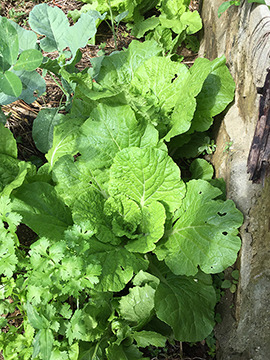
Arbusto de albahaca morada Genovese Red Freddy
Genovese Red Freddy purple basil bush

Pimentón Orange Bell con flores
Orange Bell pepper flowering

Maní
Peanuts

Zanahoria Cosmic Purple, tomate Box Car Willie detrás.
Cosmic Purple carrots with Box Car Willie tomato just behind.
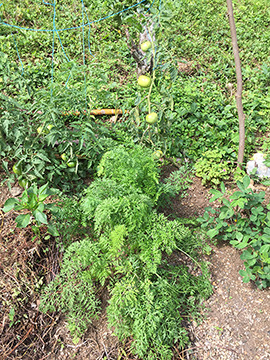
Berenjena Aswad, ají dulce criollo, un cebollín invisible y detrás 2 tomates Black Krim .
Aswad eggplant, local ají dulce, an invisible bunching onion and two Black Krim tomatoes from rooted suckers in the back there.

Tomate Black Krim repleto de fruta verde. Si su sabor se acerca su producción esta variedad es un ganador.
Black Krim tomato loaded with green fruit. If its flavor is half as good as its production this variety is a keeper.

Comfrey con un tomate híbrido Amelia acostado encima. Hago trizas de una hoja de comfrey y entierro los pedacitos alrededor de plantas hambrientas cuando las siembro, para alimentar a las plantas y atraer lombrices. Tengo unas semillas de tomates híbridos que iba a usar como patr’ones para injertar variedades vulnerables a enfermedades que pasan por las raices. Pero encontré un patrón del cual se pueden guardar las semillas - más sobre eso en otro post - así que estoy sembrando los híbridos para no derrochar las semillas.
Comfrey with a hybrid tomato Amelia sprawled out over it. I tear up a comfrey leaf and bury the pieces around particlularly needy plants when I set them out, to feed the plant and atract worms to the vicinity. I have some hybrid tomato seeds I was going to use as rootstock for grafting varieties vulnerable to soil borne diseases but I found a rootstock you can save seeds from so you don’t have to keep buying them - more on that in another post - so I’m planting the hybrids so as not to waste the seeds.

0 notes
Text
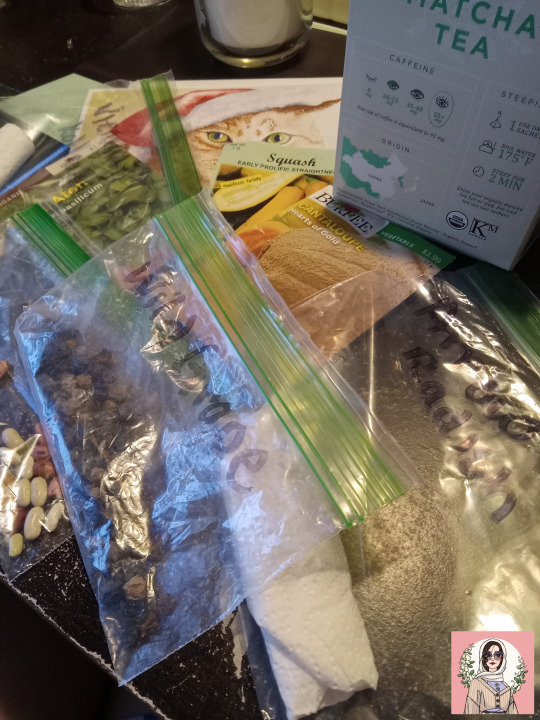
@lavendervillage sent me an absolutely lovely care package. It came in a few days ago but I've been so busy I haven't gotten the chance to sit down and go through it properly until today.
Got an absolutely wonderful bunch of seeds (including Vienna (?) Kohlrabi, Arrow Radish, Daikon Radish, Wild Grape, an unknown duo of Beans, Aton Basil, Early Prolific Straightneck Squash, and Hearts of Gold Cantaloupe), some Berry Matcha, a sticker of some Bears eating Blueberries (which I gave to my Husband because he loves both bears and Blueberries), a Stupa, and a hilarious grumpy Christmas Cat card.
My love language isn't Gifts and so I'm incredibly horrible about remembering to send mail out myself (which I feel wretched about). But I always feel so honored getting care packages like this from friends and they mean so much to me 💜
#Personal#lavendervillage#Gardening#A Dragon's Hoard of Tea#Oklahoma#Green Witch#Green Witchcraft#Witchy Gardening#Verderer#Witches Garden#Witch's Garden#Gardenblr#Plantblr
1 note
·
View note
Text




Instagram Repost: May 6, 2022
It's official. The last of the boards were put on the bench, decorations put in, and planting done today … Much to the dismay of my back and hips; I have a feeling I'll be out for a few days after this. But it's so beyond worth it, I don't even have the words
You can't see all of them but there are a LOT of plants, and a lot of varieties of plants, shoved into this tiny little space- including:
2 Tomatoes (Indigo Rose, Stripy Boy);
2 Okra (Clemson Spineless, Red Burgundy);
1 Corn (Jaws Hybrid);
4 Sunflowers (Russian Giant, Red Sun, Ruby Eclipse, Dwarf Teddy Bear);
2 Eggplants (Black Beauty, Early Long Purple);
5 Peppers (Poblano, Rainbow Cayenne, Multicolored Habanero, Carnival Sweet Pepper, Mild Jalapeno, Early Jalapeno);
2 Summer Squash (Saffron Straightneck, Early Prolific Straightneck);
2 Cucumbers (Lemon, White Wonder);
1 Zucchini (Black Beauty);
2 Peas (Cascadia Sugar Snap, Snowbird);
3 Beans (Cherokee Wax, Royal Burgundy, Asparagus Yardlong Red Seeded);
1 Blueberry (Bountiful Blue);
2 Parsley (Italian Flatleaf, Single Leaf);
1 Dill (Fernleaf);
1 Chamomile (German);
1 Rosemary;
1 Lavender (Spanish);
5 Basil (Lemondrop, Lime, Dark Opal Purple, Siam Queen, Genovese);
2 Sage (Pineapple, Broadleaf);
1 Comfrey;
1 Oregano (Greek);
1 Thyme (Italian);
2 Cilantro / Coriander (Confetti, Leaf);
1 Chinese Peony (Sorbet);
1 Chinese Hibiscus (Social Butterfly);
1 Korean Lilac (Miss Kim);
1 Passionflower (Maypop).
It feels good to sink my hands into the dirt after being too ill to garden during my recovery. And it's still far harder on my body than it's ever been before- which on some days is discouraging as hell; adjusting to such a sudden and massive change in my disability level has been mind breaking in numerous ways … But I haven't been this happy in an incredibly long time. Now here's to hoping it all grows 🤣🙏🤞
This blog belongs to a «Multi-Neuroatypical + Multi-Disabled» «Queer» «Childless» «Jewish + Pagan» «NonTraditionalist» Homemaker. TradWives are unwelcome.
#Instagram Reposts#Personal#2022#Garden 2022#Gardening#Around My Home#Green Witch#Green Witchcraft#Oklahoma#Witchy Gardening#Quick References#Homemaking#Homemaker#Housewife#NonTrad Homemaker#NonTrad Housewife#NonTrad Homemaking
1 note
·
View note
Text
Complete Seed Inventory 2023
Tomato
Black Cherry (Sow Easy Coated Seeds)
Indigo Rose
Okra
Red Burgundy
Clemson Spineless (NOT #80 subvariety)
Eggplant
Early Long Purple
Black Beauty
Peppers
Bell Peppers, Sweet Carnival Blend
Habanero, Color Blend
Cayenne, Color Blend
Poblano
Jalapeño, Mild
Jalapeño, Early
Fresno (Currently on loan to the MG)
Banana Pepper, Sweet (Currently on loan to the MG)
Corn
Sweet, Jaws Hybrid
Peas
Snow Pea, Snowbird
Sugar Snap, Cascadia
Beans
Yardlong, Asparagus Red-Seeded
Garden, Cherokee Wax
Bush, Royal Burgundy
Lima, Large Speckled Christmas
Melons
Honeydew, Green
Cantaloupe, Honey Rock
Watermelon, Moon and Stars
Winter Squash
Pumpkin, Early Sweet Sugar Pie
General Squash, Honeynut
General Squash, Table Gold
General Squash, Waltham Butternut
Summer Squash
Yellow Squash, Early Prolific Straightneck
Yellow Squash, Saffron Prolific Straight Neck
Zucchini, Black Beauty
Cucumbers
White Wonder
Lemon
Carrots
Kaleidoscope Blend (Seed Tape)
Red-Cored Chantenay
Beets
Colorful Mix
Radishes
French Breakfast
Purple Top White Globe
Base Brassicas
Cabbage, Early Golden Acre
Cabbage, Charleston Wakefield
Lettuce, Buttercrunch
Cauliflower, Snowball Y
Brussel Sprouts, Catskill
Brussel Sprouts, Long Island Improved (Sow Easy Coated Seeds)
Allium
Chives, Unknown
Chives, Garlic
Chives, Dolores
Leek, Early Giant
Bulb "Herbs"
Fennel, Unknown
Fennel, Florence
Kohlrabi, Early White Vienna
Leafy Greens
Bok Choy, Toy Choy
Swiss Chard, Color Mix
Mustard, India Florida Broad Leaf
Collard Greens, Georgia Southern / Creole
Roquette, Arugula
Mesclun, Gourmet Greens Mix
Spinach, Bloomsdale Long Standing
Herbs
Cilantro, Slo-Bolt
Cilantro, Unknown
Cilantro, Common
Parsley, Italian
Parsley, Single Leaf Italian
French Parsley / Chervil
Dill, Unknown
Dill, Fernleaf
Rosemary, Unknown
Rosemary, Common
Lavender, Unknown
Lavender, English
Tarragon, Common
Tarragon, Unknown
Savory, Winter
Savory, Summer
Thyme, "Lebanese Za'atar" (Technically not a true Za'atar)
Thyme, Common
Thyme, Unknown
Oregano, Unknown
Oregano, Greek
Marjoram, Sweet (x2)
Marjoram, Unknown
Sage, Broadleaf
Sage, Unknown
Sage, Black
Sage, Purple
Holy Basil / Tulsi, Temperate
Basil, Spicy Sabre
Basil, Lime
Basil, Lemondrop
Basil, Genovese
Basil, Siam Queen
Basil, Dark Purple Opal
Mint, Spearmint
Mint, Peppermint
Mint, Mountain Mint
Mint, Mountain Mint, Unknown
Catnip, Unknown
Catnip, Common
Lemon Balm, Common
Lemon Balm, Unknown
Lemon Balm, Mandarina Orange Balm
Bergamot, Wild
Horehound, White
Valerian, Official
Lovage
Rue
Hyssop, Official
Wormwood, Absinthe
Wormwood, Prairie Sage
Comfrey, True
Mullein, Common
Mugwort, California
Tobacco, Woodland Flowering
Flowers
False Chamomile, German
Echinacea, Purple
Goldenrod, Showy
Goldenrod, Zig Zag
Cardinal Flower
False Passionflower (actually INVASIVE Sweet Autumn Clematis)
True Passionflower
Poppy, Oriental, Color Mix
Lupine, Russel Hybrid, Color Mix
Hollyhock, Summer Carnival Color Mix
Sunflower, Mammoth Grey Stripe
Sunflower, Magic Roundabout
Sunflower, Italian White
Sunflower, Chianti Hybrid
Sunflower, Ruby Sun
Sunflower, Ruby Eclipse
Sunflower, Russian Giant
Sunflower, Dwarf Teddy Bear
#Personal#Gardening#Garden 2023#Verderer#Domestic Witch#Domestic Witchcraft#Green Witch#Green Witchcraft#Cottage Witch#Cottage Witchcraft#Quick References
2 notes
·
View notes
Text

Instagram Repost: May 11, 2022
Repotted the Hibiscus today after noticing her pot kept holding on to too much water and she wasn't doing as well as she should be at this stage. In doing so, I discovered a whole host of seedlings were already starting to come up!
All 5 of my Basil varieties have at least some sprouts; 1 of the Indigo Rose Tomatoes have sprouted (out of the 6 seeds I planted to ensure I at least got one), 1 of the Russian Giant sunflowers, plus 1 of the Red Sun Sunflowers, and 1 of the Teddy Bear Dwarf Sunflowers; all 4 of the Corn; 3 / 4 of the Okras (1 of the Royal Burgundy, both of the Clemson Spineless); and 1 / 2 of the Cucumbers (Lemon), and both the Squashes (Saffron Straightneck and Early Prolific Straightneck); 1 / 3 of the Fernleaf Dills; and 1 / 2 of the Snowbird Peas. Plus the German Chamomile I’d already clocked seedlings on
I genuinely did not expect vegetable seedlings so quickly. I’m so ecstatic.
#Verderer#Gardening#Garden 2022#Instagram Reposts#2022#Personal#Green Witch#Green Witchcraft#Oklahoma#Witchy Gardening#Witches Garden#Witch's Garden#Gardenblr#Plantblr
0 notes
Text
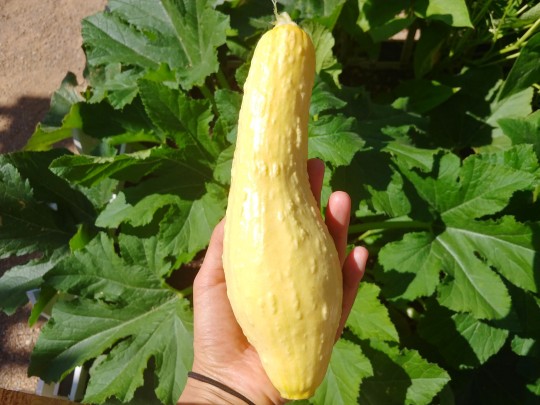

06/04/2020: It looks like one of the squash plants is Early Prolific Straightneck Squash. It has nice soft yellow color but when you hold it, you feel the tiny needles sticking out from the skin.
I also found this conjoined twin squash😀. It looks like I can stop buying squash for a while. As it says on its name, the plan seems to be very prolific!
#las vegas gardening#gardeners on tumblr#gardening#summer vegetables#vegetables#las vegas gardeners#early prolific straightneck squash#squash#gardenblr
0 notes
Text

Day 30 on this Early Prolific Straightneck yellow squash. The seed packet says 45 days. While I couldn’t be happier with the foliage, it hasn’t started setting flowers. I suspect it’ll be at least another 30, but hopefully I’ll get a harvest before the frost.
0 notes